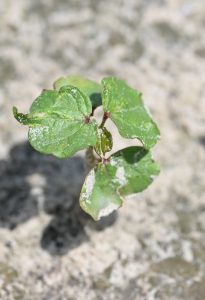
Tobacco thrips, Frankliniella fusca, adult on the underside of a cotyledon. Image: Isaac L. Esquivel.
We are now a few weeks into our planting the season for cotton and peanut, with some planting as early as the first week of April. As the planting season continues, I wanted to bring a few things to your attention relating to early-season insect pests.
Our first pest we face for both cotton and peanut is going to be thrips, and we need to ask a couple of questions: 1) What does the thrips situation look like? and 2) When/what are we going to need to spray? Normally, for the past 5 years, thrips activity has been high, starting in early April, and has decreased as we approach mid-May. However, with this year’s freeze and snow across the Panhandle, thrips populations appear to be building more slowly. Starting in late February, we have been sampling off-season weeds on grower fields across the region and finding relatively few tobacco thrips. In the past 3 weeks, thrips populations have been increasing on weed samples. So, it is looking like peak activity is going to be a little later than in previous years.
–
Thrips Management in Cotton
The best option for thrips management comes at planting in the form of an insecticide seed treatment (ISTs) of imidacloprid or an in-furrow insecticide application of either imidacloprid or aldicarb (AgLogic). The performance of in-furrow insecticides and ISTs will vary by year and location. The variation is driven by weather and the extent of thrips pressure. If you have high thrips pressure or less than ideal growing conditions during seedling stages, IST fields may require a foliar application to supplement the IST. Under low thrips pressure and good growing conditions, ISTs can do a good job without needing a supplemental foliar application.
When it comes to if a foliar application is necessary, it is important to get out, take a look, and assess the injury. Cotton is most susceptible to thrips injury from the cotyledon and 1st true leaf up to the 5th true leaf. After the 5th true leaf with vigorous growth, foliar application is not recommended. The recommended threshold for thrips is 25% or more of your plants sampled are showing moderate to significant thrips injury, and an average of two or more immature thrips are present, treatment may be necessary. As far as foliar options, Acephate (3 oz/A) is an effective and rather economical option. Pyrethroids are not recommended to control thrips and have the potential to flare secondary pests like aphids and spider mites down the road.
–
Thrips Management in Peanut
Our only option for thrips and Tomato Spotted Wilt (TSWV) management come at planting with in-furrow insecticides.
If you have not planted yet, I would highly recommend using Phorate (Thimet @ 5-7.5 lbs./A) in-furrow for thrips management. It is the only option that will BOTH kill thrips and reduce the chances of tomato spotted wilt infection. Other in-furrow options like imidacloprid will kill thrips but WILL NOT reduce the incidence of tomato spotted wilt. If you are worried about thrips after the furrow is closed, we can make foliar insecticide applications to manage thrips, but these sprays will NOT reduce the risk of TSWV. Contact your county extension agent or myself if you are considering a foliar application. For more information about peanut production and peanut insect management, read the Insect and Mite Pest Management in Florida Peanut publication on the Florida Peanut Team Website.


